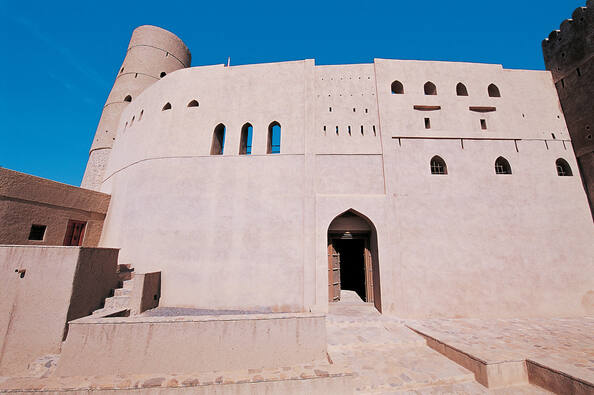Fuerte de Bahla
Bahla Fort
The oasis of Bahla owes its prosperity to the Banu Nebhan, the dominant tribe in the area from the 12th to the end of the 15th century. The ruins of the immense fort, with its walls and towers of unbaked brick and its stone foundations, is a remarkable example of this type of fortification and attests to the power of the Banu Nebhan.
La description est disponible sous licence CC-BY-SA IGO 3.0
Fort de Bahla
L'oasis de Bahla doit sa prospérité aux Banu Nabhan, qui s'imposèrent aux autres communautés entre le XIIe siècle et la fin du XVe. Leur puissance est attestée par les ruines de l'immense fort aux murailles et aux tours de brique crue et au soubassement de pierre, exemple remarquable de ce type de fortification.
La description est disponible sous licence CC-BY-SA IGO 3.0
قلعة بهلا
تدين واحة بهلا الصحراوية بازدهارها لبني نبهان الذين فرضوا سيطرتهم على باقي المجتمعات بين القرن الثاني عشر ونهاية القرن الخامس عشر. وتظهر قوّتهم من خلال أنقاض القلعة الكبيرة التي تتميز بجدران وأبراج من الآجر الخام ومن أسس حجرية وهي المثال الواضح لهذا النوع من التحصينات.
source: UNESCO/CPE
La description est disponible sous licence CC-BY-SA IGO 3.0
巴赫莱要塞
巴赫莱绿洲的繁荣应归功于巴努·内布罕部落,这一部落从12世纪到15世纪晚期一直统治着这个地区。这个庞大堡垒的废墟有土制的城墙和碉堡以及用石头打的地基,是此类型防御工事中突出的例子,由此也可以看出巴努·内布罕部落的实力。
source: UNESCO/CPE
La description est disponible sous licence CC-BY-SA IGO 3.0
Крепость Бахла
Оазис Бахла обязан своим процветанием бану-небхан – основному племени этого района в период XII-конца XV в. Руины огромного форта с его стенами и башнями из сырцового кирпича на каменных основаниях – замечательный пример такого рода укреплений, свидетельствующий о могуществе этого племени.
source: UNESCO/CPE
La description est disponible sous licence CC-BY-SA IGO 3.0
Fuerte de Bahla
El oasis de Bahla debió su prosperidad a la tribu de los Banu Nebhan, que impuso su dominación sobre el conjunto de los clanes de la región desde el siglo XII hasta finales del siglo XV. Son testigos de su poderío los vestigios del inmenso fuerte de murallas y torres de ladrillo crudo con cimientos de piedra que erigieron. Esta fortificación constituye un ejemplo notable de las edificaciones de este tipo.
source: UNESCO/CPE
La description est disponible sous licence CC-BY-SA IGO 3.0
バハラ城塞
オマーン北部、標高約3000mのアフダル山麓にある城塞都市。BC3世紀より開け、7~15世紀には海のシルクロードの中継地として栄えた。遊牧民やペルシア人の攻撃、略奪から自衛するために砦や城塞が発達し、その最大規模の偉容を誇るのがバフラ城塞で、全長は12kmである。しかしながら日干しレンガ造りのため耐久力が無く、オマーン政府の財政難で急速に崩壊が進んでいる。1988年には危機にさらされている世界遺産リストにも登録された。source: NFUAJ
Fort Bahla
Bahla was het centrum van het Ibadisme (een stroming binnen de islam). De oase van Bahla dankt zijn welvaart aan de Banu Nebhan, de dominante stam in het gebied van de 12e eeuw tot het einde van de 15e eeuw na Christus. De belangrijkste elementen van het architectonische geheel van Bahla zijn intact gebleven. Samen vormen ze een integraal en grotendeels voltooide, historische ommuurde nederzetting en een groot verdedigingswerk. De ruïnes van het immense fort – met muren en torens van ongebakken baksteen en stenen fundamenten – zijn een opmerkelijk voorbeeld van dit type vestingwerken en getuigen van de macht van de Banu Nebhan.
Source : unesco.nl
